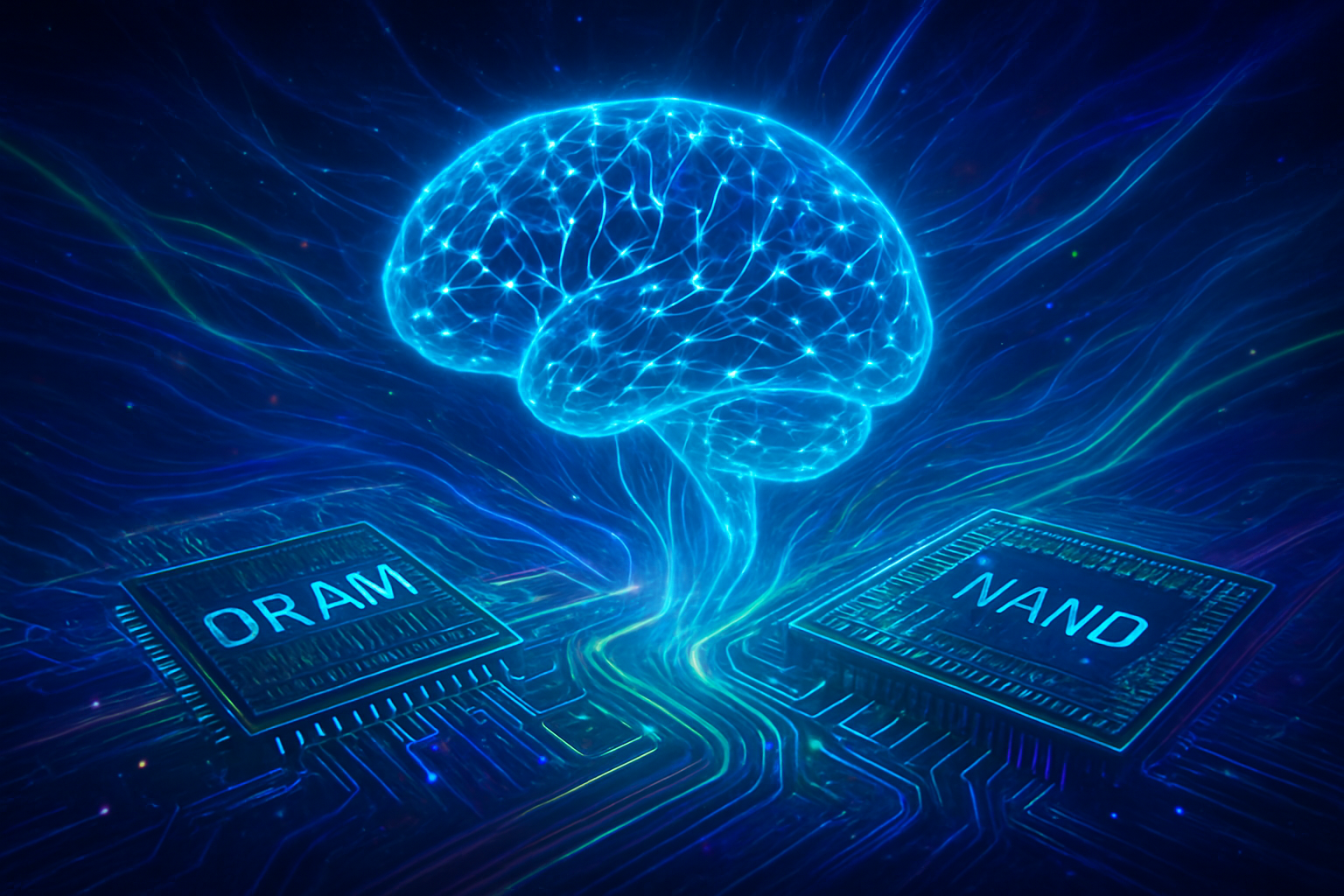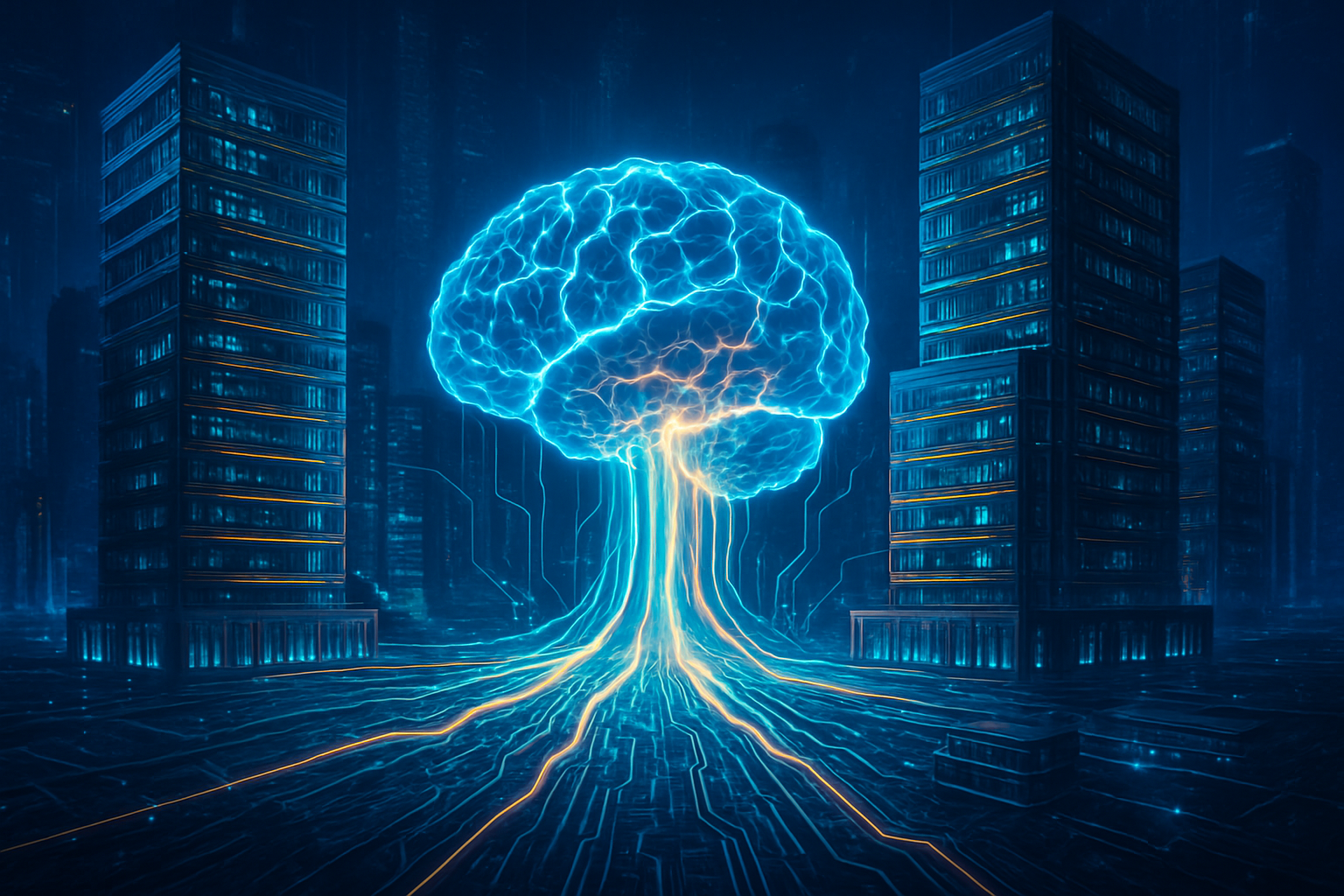Micron Technology (NASDAQ: MU) is currently experiencing an unprecedented surge in its stock performance, reflecting a profound shift in the semiconductor sector, particularly within the memory chip market. As of late October 2025, the company's shares have not only reached all-time highs but have also significantly outpaced broader market indices, with a year-to-date gain of over 166%. This remarkable momentum is largely attributed to Micron's exceptional financial results and, more critically, the insatiable demand for high-bandwidth memory (HBM) driven by the accelerating artificial intelligence (AI) revolution.
The immediate significance of Micron's ascent extends beyond its balance sheet, signaling a robust and potentially prolonged "super cycle" for the entire memory industry. Investor sentiment is overwhelmingly bullish, as the market recognizes AI's transformative impact on memory chip requirements, pushing both DRAM and NAND prices upwards after a period of oversupply. Micron's strategic pivot towards high-margin, AI-centric products like HBM is positioning it as a pivotal player in the global AI infrastructure build-out, reshaping the competitive landscape for memory manufacturers and influencing the broader technology ecosystem.
The AI Engine: HBM3E and the Redefinition of Memory Demand
Micron Technology's recent success is deeply rooted in its strategic technical advancements and its ability to capitalize on the burgeoning demand for specialized memory solutions. A cornerstone of this momentum is the company's High-Bandwidth Memory (HBM) offerings, particularly its HBM3E products. Micron has successfully qualified its HBM3E with NVIDIA (NASDAQ: NVDA) for the "Blackwell" AI accelerator platform and is actively shipping high-volume HBM to four major customers across GPU and ASIC platforms. This advanced memory technology is critical for AI workloads, offering significantly higher bandwidth and lower power consumption compared to traditional DRAM, which is essential for processing the massive datasets required by large language models and other complex AI algorithms.
The technical specifications of HBM3E represent a significant leap from previous memory architectures. It stacks multiple DRAM dies vertically, connected by through-silicon vias (TSVs), allowing for a much wider data bus and closer proximity to the processing unit. This design dramatically reduces latency and increases data throughput, capabilities that are indispensable for high-performance computing and AI accelerators. Micron's entire 2025 HBM production capacity is already sold out, with bookings extending well into 2026, underscoring the unprecedented demand for this specialized memory. HBM revenue for fiscal Q4 2025 alone approached $2 billion, indicating an annualized run rate of nearly $8 billion.
This current memory upcycle fundamentally differs from previous cycles, which were often driven by PC or smartphone demand fluctuations. The distinguishing factor now is the structural and persistent demand generated by AI. Unlike traditional commodity memory, HBM commands a premium due to its complexity and critical role in AI infrastructure. This shift has led to an "unprecedented" demand for DRAM from AI, causing prices to surge by 20-30% across the board in recent weeks, with HBM seeing even steeper jumps of 13-18% quarter-over-quarter in Q4 2025. Even the NAND flash market, after nearly two years of price declines, is showing strong signs of recovery, with contract prices expected to rise by 5-10% in Q4 2025, driven by AI and high-capacity applications.
Initial reactions from the AI research community and industry experts have been overwhelmingly positive, highlighting the critical enabler role of advanced memory in AI's progression. Analysts have upgraded Micron's ratings and raised price targets, recognizing the company's successful pivot. The consensus is that the memory market is entering a new "super cycle" that is less susceptible to the traditional boom-and-bust patterns, given the long-term structural demand from AI. This sentiment is further bolstered by Micron's expectation to achieve HBM market share parity with its overall DRAM share by the second half of 2025, solidifying its position as a key beneficiary of the AI era.
Ripple Effects: How the Memory Supercycle Reshapes the Tech Landscape
Micron Technology's (NASDAQ: MU) surging fortunes are emblematic of a profound recalibration across the entire technology sector, driven by the AI-powered memory chip supercycle. While Micron, along with its direct competitors like SK Hynix (KRX: 000660) and Samsung Electronics (KRX: 005930), stands as a primary beneficiary, the ripple effects extend to AI chip developers, major tech giants, and even nascent startups, reshaping competitive dynamics and strategic priorities.
Other major memory producers are similarly thriving. South Korean giants SK Hynix (KRX: 000660) and Samsung Electronics (KRX: 005930) have also reported record profits and sold-out HBM capacities through 2025 and well into 2026. This intense demand for HBM means that while these companies are enjoying unprecedented revenue and margin growth, they are also aggressively expanding production, which in turn impacts the supply and pricing of conventional DRAM and NAND used in PCs, smartphones, and standard servers. For AI chip developers such as NVIDIA (NASDAQ: NVDA), Advanced Micro Devices (NASDAQ: AMD), and Intel (NASDAQ: INTC), the availability and cost of HBM are critical. NVIDIA, a primary driver of HBM demand, relies heavily on its suppliers to meet the insatiable appetite for its AI accelerators, making memory supply a key determinant of its scaling capabilities and product costs.
For major AI labs and tech giants like OpenAI, Alphabet (NASDAQ: GOOGL), Amazon (NASDAQ: AMZN), Microsoft (NASDAQ: MSFT), and Meta Platforms (NASDAQ: META), the supercycle presents a dual challenge and opportunity. These companies are the architects of the AI boom, investing billions in infrastructure projects like OpenAI’s "Stargate." However, the rapidly escalating prices and scarcity of HBM translate into significant cost pressures, impacting the margins of their cloud services and the budgets for their AI development. To mitigate this, tech giants are increasingly forging long-term supply agreements with memory manufacturers and intensifying their in-house chip development efforts to gain greater control over their supply chains and optimize for specific AI workloads, as seen with Google’s (NASDAQ: GOOGL) TPUs.
Startups, while facing higher barriers to entry due to elevated memory costs and limited supply access, are also finding strategic opportunities. The scarcity of HBM is spurring innovation in memory efficiency, alternative architectures like Processing-in-Memory (PIM), and solutions that optimize existing, cheaper memory types. Companies like Enfabrica, backed by NVIDIA (NASDAQ: NVDA), are developing systems that leverage more affordable DDR5 memory to help AI companies scale cost-effectively. This environment fosters a new wave of innovation focused on memory-centric designs and efficient data movement, which could redefine the competitive landscape for AI hardware beyond raw compute power.
A New Industrial Revolution: Broadening Impacts and Lingering Concerns
The AI-driven memory chip supercycle, spearheaded by companies like Micron Technology (NASDAQ: MU), signifies far more than a cyclical upturn; it represents a fundamental re-architecture of the global technology landscape, akin to a new industrial revolution. Its impacts reverberate across economic, technological, and societal spheres, while also raising critical concerns about accessibility and sustainability.
Economically, the supercycle is propelling the semiconductor industry towards unprecedented growth. The global AI memory chip design market, estimated at $110 billion in 2024, is forecast to skyrocket to nearly $1.25 trillion by 2034, exhibiting a staggering compound annual growth rate of 27.50%. This surge is translating into substantial revenue growth for memory suppliers, with conventional DRAM and NAND contract prices projected to see significant increases through late 2025 and into 2026. This financial boom underscores memory's transformation from a commodity to a strategic, high-value component, driving significant capital expenditure and investment in advanced manufacturing facilities, particularly in the U.S. with CHIPS Act funding.
Technologically, the supercycle highlights a foundational shift where AI advancement is directly bottlenecked and enabled by hardware capabilities, especially memory. High-Bandwidth Memory (HBM), with its 3D-stacked architecture, offers unparalleled low latency and high bandwidth, serving as a "superhighway for data" that allows AI accelerators to operate at their full potential. Innovations are extending beyond HBM to concepts like Compute Express Link (CXL) for in-memory computing, addressing memory disaggregation and latency challenges in next-generation server architectures. Furthermore, AI itself is being leveraged to accelerate chip design and manufacturing, creating a symbiotic relationship where AI both demands and empowers the creation of more advanced semiconductors, with HBM4 memory expected to commercialize in late 2025.
Societally, the implications are profound, as AI-driven semiconductor advancements spur transformations in healthcare, finance, manufacturing, and autonomous systems. However, this rapid growth also brings critical concerns. The immense power demands of AI systems and data centers are a growing environmental issue, with global AI energy consumption projected to increase tenfold, potentially exceeding Belgium’s annual electricity use by 2026. Semiconductor manufacturing is also highly water-intensive, raising sustainability questions. Furthermore, the rising cost and scarcity of advanced AI resources could exacerbate the digital divide, potentially favoring well-funded tech giants over smaller startups and limiting broader access to cutting-edge AI capabilities. Geopolitical tensions and export restrictions also contribute to supply chain stress and could impact global availability.
This current AI-driven memory chip supercycle fundamentally differs from previous AI milestones and tech booms. Unlike past cycles driven by broad-based demand for PCs or smartphones, this supercycle is fueled by a deeper, structural shift in how computers are built, with AI inference and training requiring massive and specialized memory infrastructure. Previous breakthroughs focused primarily on processing power; while GPUs remain indispensable, specialized memory is now equally vital for data throughput. This era signifies a departure where memory, particularly HBM, has transitioned from a supporting component to a critical, strategic asset and the central bottleneck for AI advancement, actively enabling new frontiers in AI development. The "memory wall"—the performance gap between processors and memory—remains a critical challenge that necessitates fundamental architectural changes in memory systems, distinguishing this sustained demand from typical 2-3 year market fluctuations.
The Road Ahead: Memory Innovations Fueling AI's Next Frontier
The trajectory of AI's future is inextricably linked to the relentless evolution of memory technology. As of late 2025, the industry stands on the cusp of transformative developments in memory architectures that will enable increasingly sophisticated AI models and applications, though significant challenges related to supply, cost, and energy consumption remain.
In the near term (late 2025-2027), High-Bandwidth Memory (HBM) will continue its critical role. HBM4 is projected for mass production in 2025, promising a 40% increase in bandwidth and a 70% reduction in power consumption compared to HBM3E, with HBM4E following in 2026. This continuous improvement in HBM capacity and efficiency is vital for the escalating demands of AI accelerators. Concurrently, Low-Power Double Data Rate 6 (LPDDR6) is expected to enter mass production by late 2025 or 2026, becoming indispensable for edge AI devices such as smartphones, AR/VR headsets, and autonomous vehicles, enabling high bandwidth at significantly lower power. Compute Express Link (CXL) is also rapidly gaining traction, with CXL 3.0/3.1 enabling memory pooling and disaggregation, allowing CPUs and GPUs to dynamically access a unified memory pool, a powerful capability for complex AI/HPC workloads.
Looking further ahead (2028 and beyond), the memory roadmap envisions HBM5 by 2029, doubling I/O count and increasing bandwidth to 4 TB/s per stack, with HBM6 projected for 2032 to reach 8 TB/s. Beyond incremental HBM improvements, the long-term future points to revolutionary paradigms like In-Memory Computing (IMC) or Processing-in-Memory (PIM), where computation occurs directly within or very close to memory. This approach promises to drastically reduce data movement, a major bottleneck and energy drain in current architectures. IBM Research, for instance, is actively exploring analog in-memory computing with 3D analog memory architectures and phase-change memory, while new memory technologies like Resistive Random-Access Memory (ReRAM) and Magnetic Random-Access Memory (MRAM) are being developed for their higher density and energy efficiency in IMC applications.
These advancements will unlock a new generation of AI applications. Hyper-personalization and "infinite memory" AI are on the horizon, allowing AI systems to remember past interactions and context for truly individualized experiences across various sectors. Real-time AI at the edge, powered by LPDDR6 and emerging non-volatile memories, will enable more sophisticated on-device intelligence with low latency. HBM and CXL are essential for scaling Large Language Models (LLMs) and generative AI, accelerating training and reducing inference latency. Experts predict that agentic AI, capable of persistent memory, long-term goals, and multi-step task execution, will become mainstream by 2027-2028, potentially automating entire categories of administrative work.
However, the path forward is fraught with challenges. A severe global shortage of HBM is expected to persist through 2025 and into 2026, leading to price hikes and potential delays in AI chip shipments. The advanced packaging required for HBM integration, such as TSMC’s (NYSE: TSM) CoWoS, is also a major bottleneck, with demand far exceeding capacity. The high cost of HBM, often accounting for 50-60% of an AI GPU’s manufacturing cost, along with rising prices for conventional memory, presents significant financial hurdles. Furthermore, the immense energy consumption of AI workloads is a critical concern, with memory subsystems alone accounting for up to 50% of total system power. Global AI energy demand is projected to double from 2022 to 2026, posing significant sustainability challenges and driving investments in renewable power and innovative cooling techniques. Experts predict that memory-centric architectures, prioritizing performance per watt, will define the future of sustainable AI infrastructure.
The Enduring Impact: Micron at the Forefront of AI's Memory Revolution
Micron Technology's (NASDAQ: MU) extraordinary stock momentum in late 2025 is not merely a fleeting market trend but a definitive indicator of a fundamental and enduring shift in the technology landscape: the AI-driven memory chip supercycle. This period marks a pivotal moment where advanced memory has transitioned from a supporting component to the very bedrock of AI's exponential growth, with Micron strategically positioned at its epicenter.
Key takeaways from this transformative period include Micron's successful evolution from a historically cyclical memory company to a more stable, high-margin innovator. Its leadership in High-Bandwidth Memory (HBM), particularly the successful qualification and high-volume shipments of HBM3E for critical AI platforms like NVIDIA’s (NASDAQ: NVDA) Blackwell accelerators, has solidified its role as an indispensable enabler of the AI revolution. This strategic pivot, coupled with disciplined supply management, has translated into record revenues and significantly expanded gross margins, signaling a robust comeback and establishing a "structurally higher margin floor" for the company. The overwhelming demand for Micron's HBM, with 2025 capacity sold out and much of 2026 secured through long-term agreements, underscores the sustained nature of this supercycle.
In the grand tapestry of AI history, this development is profoundly significant. It highlights that the "memory wall"—the performance gap between processors and memory—has become the primary bottleneck for AI advancement, necessitating fundamental architectural changes in memory systems. Micron's ability to innovate and scale HBM production directly supports the exponential growth of AI capabilities, from training massive large language models to enabling real-time inference at the edge. The era where memory was treated as a mere commodity is over; it is now recognized as a critical strategic asset, dictating the pace and potential of artificial intelligence.
Looking ahead, the long-term impact for Micron and the broader memory industry appears profoundly positive. The AI supercycle is establishing a new paradigm of more stable pricing and higher margins for leading memory manufacturers. Micron's strategic investments in capacity expansion, such as its $7 billion advanced packaging facility in Singapore, and its aggressive development of next-generation HBM4 and HBM4E technologies, position it for sustained growth. The company's focus on high-value products and securing long-term customer agreements further de-risks its business model, promising a more resilient and profitable future.
In the coming weeks and months, investors and industry observers should closely watch Micron's Q1 Fiscal 2026 earnings report, expected around December 17, 2025, for further insights into its HBM revenue and forward guidance. Updates on HBM capacity ramp-up, especially from its Malaysian, Taichung, and new Hiroshima facilities, will be critical. The competitive dynamics with SK Hynix (KRX: 000660) and Samsung (KRX: 005930) in HBM market share, as well as the progress of HBM4 and HBM4E development, will also be key indicators. Furthermore, the evolving pricing trends for standard DDR5 and NAND flash, and the emerging demand from "Edge AI" devices like AI-enhanced PCs and smartphones from 2026 onwards, will provide crucial insights into the enduring strength and breadth of this transformative memory supercycle.
This content is intended for informational purposes only and represents analysis of current AI developments.
TokenRing AI delivers enterprise-grade solutions for multi-agent AI workflow orchestration, AI-powered development tools, and seamless remote collaboration platforms.
For more information, visit https://www.tokenring.ai/.



